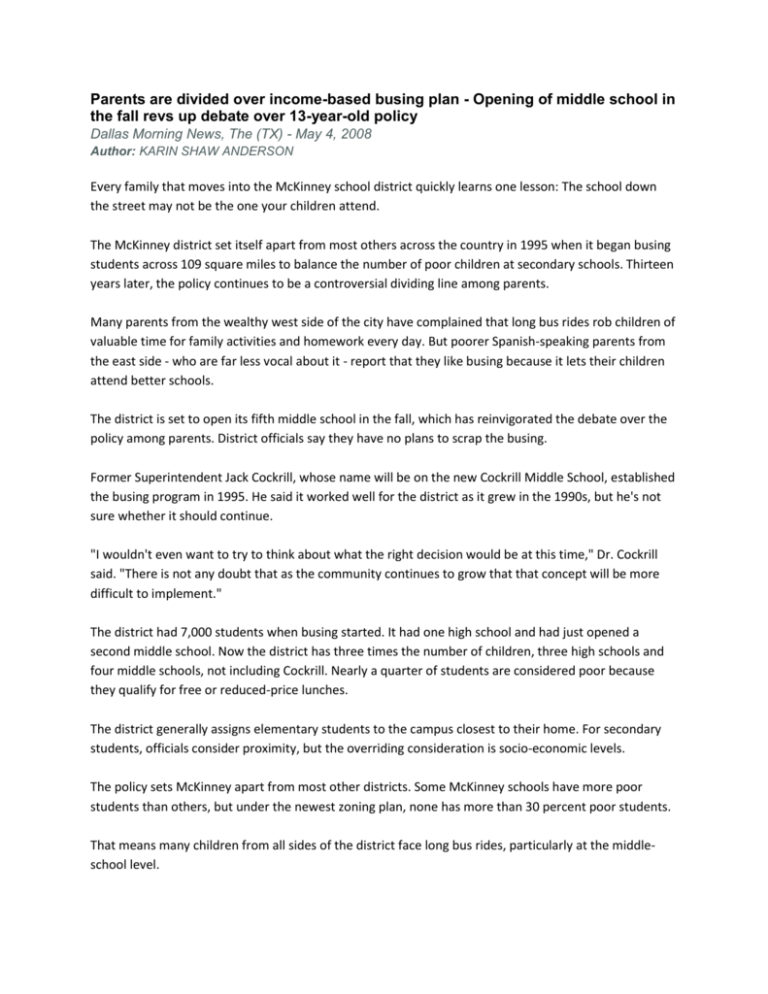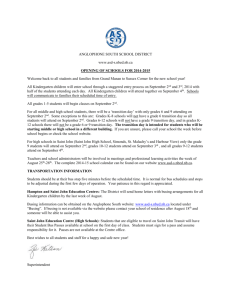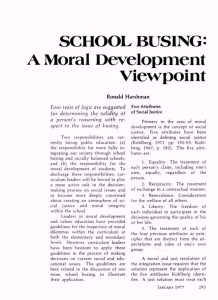There has been great success in the academic
advertisement

Parents are divided over income-based busing plan - Opening of middle school in the fall revs up debate over 13-year-old policy Dallas Morning News, The (TX) - May 4, 2008 Author: KARIN SHAW ANDERSON Every family that moves into the McKinney school district quickly learns one lesson: The school down the street may not be the one your children attend. The McKinney district set itself apart from most others across the country in 1995 when it began busing students across 109 square miles to balance the number of poor children at secondary schools. Thirteen years later, the policy continues to be a controversial dividing line among parents. Many parents from the wealthy west side of the city have complained that long bus rides rob children of valuable time for family activities and homework every day. But poorer Spanish-speaking parents from the east side - who are far less vocal about it - report that they like busing because it lets their children attend better schools. The district is set to open its fifth middle school in the fall, which has reinvigorated the debate over the policy among parents. District officials say they have no plans to scrap the busing. Former Superintendent Jack Cockrill, whose name will be on the new Cockrill Middle School, established the busing program in 1995. He said it worked well for the district as it grew in the 1990s, but he's not sure whether it should continue. "I wouldn't even want to try to think about what the right decision would be at this time," Dr. Cockrill said. "There is not any doubt that as the community continues to grow that that concept will be more difficult to implement." The district had 7,000 students when busing started. It had one high school and had just opened a second middle school. Now the district has three times the number of children, three high schools and four middle schools, not including Cockrill. Nearly a quarter of students are considered poor because they qualify for free or reduced-price lunches. The district generally assigns elementary students to the campus closest to their home. For secondary students, officials consider proximity, but the overriding consideration is socio-economic levels. The policy sets McKinney apart from most other districts. Some McKinney schools have more poor students than others, but under the newest zoning plan, none has more than 30 percent poor students. That means many children from all sides of the district face long bus rides, particularly at the middleschool level. Jay McFarland, one of many west-side parents who spoke at a Cockrill zoning meeting, said all students suffer. "The one resource that we all have is 24 hours in the day," Mr. McFarland said. "That's all I have. I have no more than that. Under this program, we have lost two hours - one hour on each side of the day - to busing my daughter across town." But the long rides don't bother some parents who live in the city's older sections. They were largely absent or silent at rezoning meetings, but several of them have since said they like the unusual policy. Andrea Martinez said she wouldn't trade the instruction her daughters receive for a shorter ride. Fabiola and Maria Susanna Martinez go to Evans Middle School, near the southwest edge of the school district, more than seven miles from their home. "My girls get special programs and help at Evans that they wouldn't get at another school," she said through an interpreter. Tom Crowe, the district's superintendent, has continued the busing practice since he arrived in 2004. He said it has improved performance among poor students. In 2003, 40 percent of poor students at Faubion Middle School mastered all portions of the TAKS test, state records show. By 2007, that number had grown to 70 percent. Statewide, poor middle-school students improved by 28 percentage points during that time. "There has been great success in the academic progress made by all of our students," Mr. Crowe said. Going forward, Mr. Crowe said he has no plans to end the busing. Kevin Keller, a parent, said he might not have bought his house last summer if he had known about it. He lives closest to Dowell Middle School but is zoned for Faubion on the other side of Central Expressway. "You don't buy a house in Highland Park to go to school in Richardson," Mr. Keller said. Staff photographer Juan Garcia contributed to this report. Caption: PHOTO(S): 1-2. (JUAN GARCIA/Staff Photographer)1. Students from Evans Middle School head home after finishing their 30-minute bus ride from Evans in west McKinney to their houses in east McKinney.2. A school bus drives through a trailer park. Many of the mostly Hispanic students who live in the area are bused to schools in wealthier areas. The plan, which has been in place since 1995, is a controversial dividing line among parents. MAP(S): (TROY OXFORD/Staff Artist) Middle school zoning for '08-'09








